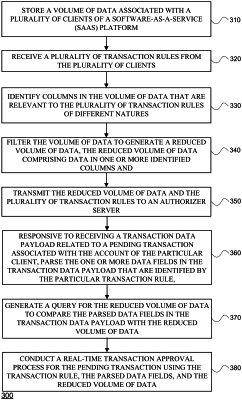| CPC G06Q 20/405 (2013.01) [G06F 16/27 (2019.01); G06N 20/00 (2019.01); G06Q 20/401 (2013.01)] | 20 Claims |

|
1. A system for reducing a response time of a transaction approval process through the use of a rule management server and a separate authorization server that specializes in the efficient approval of transactions, the system comprising:
a software-as-a-service (SaaS) platform comprising a graphical user interface configured to generate a portal for a plurality of clients to each specify one or more transaction rules associated with accounts of each client, the plurality of clients comprising a first client and a second client, wherein available transaction rules comprise a combination of available restrictions that include transaction category restrictions, named entity restrictions, dynamic rule restrictions;
the rule management server in communication with the SaaS platform, the rule management server having a first response time in applying a transaction rule, the rule management server comprising a first processor and first memory, the first memory configured to store a first set of code instructions, the first set of code instructions, when executed by the first processor, causes the first processor to:
store a first volume of data associated with the first client of the SaaS platform and a second volume of data associated with the second client of the SaaS platform,
store a third volume of data associated with a plurality of fields of third-party named entities,
receive a first transaction rule for approving transactions associated with the first client and a second transaction rule for approving transactions associated with the second client, wherein the first transaction rule includes a dynamic rule restriction that dynamically restricts transactions based on conditions of the first client, and wherein the second transaction rule includes a transaction category restriction and a third-party named entity restriction,
extract a first set of tags from the first transaction rule, the first set of tags identifying columns in the first volume of data that store data relevant to the first transaction rule;
extract a second set of tags from the second transaction rule, the second set of tags identifying columns of the third volume of data for the third-party named entity restriction to apply based on relevant fields of the third-party named entities,
identify a first set of columns in the first volume of data based on the first set tags included in the first transaction rule and a second set of columns in the third volume of data based on the second set of tags included in the second transaction rule, and
filter the first volume of transaction data to generate a first reduced volume of data and the second volume of transaction data to generate a second reduced volume of data, the first reduced volume of data comprising data in one or more columns in the identified first set of columns, the second reduced volume of data comprising data in one or more columns in the identified second set of columns; and
the authorizer server configured to approve transactions in real time, the authorizer server in communication with the rule management server, the rule management server being a separate server from the authorizer server, the authorizer server having a second response time in applying a transaction rule using a reduced volume of data, the second response time being shorter than the first response time due to the reduced volume of data, the authorizer server comprising a second processor and second memory, the second memory configured to store a second set of code instructions, the second set of code instructions, when executed by the second processor, causes the second processor to:
receive, from a transmission by the rule management server, the first reduced volume of data, the second reduced volume of data, the first transaction rule, and the second transaction rule,
store the first reduced volume of data and the second reduced volume of data in the authorizer server, the first reduced volume of data being a replication of a subset of the first volume of data that is stored in the rule management server, the second reduced volume of data being a replication of a subset of the third volume of data that is stored in the rule management server related to third-party named entities;
refresh, periodically, the first reduced volume of data through an application programming interface between the authorizer server and the rule management server, to receive dynamic conditions of the first client,
determine a condition of the dynamic rule restriction of the first transaction rule based on the received dynamic conditions of the first client,
receive a transaction data payload related to a pending transaction associated with an account of the first client,
identifying the first transaction rule governing the pending transaction,
parse one or more data fields in the transaction data payload that are identified by the first transaction rule,
generate a query for the first reduced volume of data stored in the authorizer server to compare the parsed data fields in the transaction data payload with the first reduced volume of data, and
conduct a real-time transaction approval process for the pending transaction using the first transaction rule, the parsed data fields, and the first reduced volume of data.
|